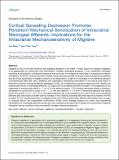| dc.contributor.author | Zhao, Jun | en_US |
| dc.contributor.author | Levy, Dan | en_US |
| dc.date.accessioned | 2017-02-18T01:58:39Z | |
| dc.date.issued | 2016 | en_US |
| dc.identifier.citation | Zhao, Jun, and Dan Levy. 2016. “Cortical Spreading Depression Promotes Persistent Mechanical Sensitization of Intracranial Meningeal Afferents: Implications for the Intracranial Mechanosensitivity of Migraine.” eNeuro 3 (6): ENEURO.0287-16.2016. doi:10.1523/ENEURO.0287-16.2016. http://dx.doi.org/10.1523/ENEURO.0287-16.2016. | en |
| dc.identifier.issn | 2373-2822 | en |
| dc.identifier.uri | http://nrs.harvard.edu/urn-3:HUL.InstRepos:30371054 | |
| dc.description.abstract | Abstract Migraine is one of the most common and disabling diseases in the world. A major feature of migraine headache is its aggravation by maneuvers that momentarily increase intracranial pressure. A key hypothesis implicates mechanical sensitization of trigeminal afferents that innervate the intracranial meninges in mediating this feature of migraine. However, whether such pain-related neural response actually develops under endogenous conditions that are linked specifically to migraine remains to be established. Single-unit recordings in the trigeminal ganglion of anesthetized male rats were combined with quantitative mechanical stimulation of the cranial dura mater to determine whether cortical spreading depression (CSD), an endogenous migraine-triggering event, affects the mechanosensitivity of meningeal afferents. CSD gave rise to an almost threefold increase in the magnitude of the responses to mechanical stimuli in 17 of 23 of the afferents tested. CSD-evoked meningeal afferent mechanosensitization occurred with a delay of 23.1 ± 2.2 min and lasted 64.1 ± 6.8 min in recording sessions that lasted for 90 min and for 177.5 ± 22.1 min in recording sessions that were extended for 240 min. Some of the sensitized afferents also developed a shorter-lasting increase in their ongoing discharge rate that was not correlated with the increase in their mechanosensitivity, suggesting that CSD-evoked meningeal afferent sensitization and increase in ongoing activity are independent phenomena. These novel findings support the notion that mechanical sensitization of meningeal afferents serves as a key nociceptive process that underlies the worsening of migraine headache during conditions that momentarily increase intracranial pressure. | en |
| dc.language.iso | en_US | en |
| dc.publisher | Society for Neuroscience | en |
| dc.relation.isversionof | doi:10.1523/ENEURO.0287-16.2016 | en |
| dc.relation.hasversion | http://www.ncbi.nlm.nih.gov/pmc/articles/PMC5242377/pdf/ | en |
| dash.license | LAA | en_US |
| dc.subject | Disorders of the Nervous System | en |
| dc.subject | afferent | en |
| dc.subject | cranial meninges | en |
| dc.subject | headache | en |
| dc.subject | mechanosensitization | en |
| dc.subject | migraine | en |
| dc.subject | trigeminal | en |
| dc.title | Cortical Spreading Depression Promotes Persistent Mechanical Sensitization of Intracranial Meningeal Afferents: Implications for the Intracranial Mechanosensitivity of Migraine | en |
| dc.type | Journal Article | en_US |
| dc.description.version | Version of Record | en |
| dc.relation.journal | eNeuro | en |
| dash.depositing.author | Zhao, Jun | en_US |
| dc.date.available | 2017-02-18T01:58:39Z | |
| dc.identifier.doi | 10.1523/ENEURO.0287-16.2016 | * |
| dash.contributor.affiliated | Zhao, Jun | |
| dash.contributor.affiliated | Levy, Dan | |


